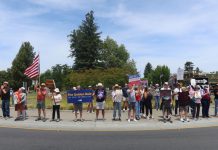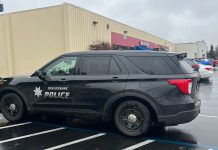SMART poll finds 72 percent of North Bay voters would
support tax to fund rail
By Barry W. Dugan, Managing Editor
Supporters of a commuter rail system for Sonoma and Marin
counties are heartened by the results of a telephone survey that
shows 72 percent of voters would vote yes for a quarter-cent sales
tax to fund the 70-mile rail system from Cloverdale to
Larkspur.
Officials of the Sonoma Marin Area Rail Transit (SMART) District
plan to put the quarter-cent sales tax on the November ballot said
the poll reflects the need to improve transportation options in the
North Bay.
“I’m excited,” said Debora Fudge, a Windsor Town
Councilmember and a member of the SMART board of directors.
“We’re land-locked up here. We need alternatives.”
Fudge said the level of support among voters didn’t surprise
her. “The results tell us that people are finally
realizing that a two or three-lane freeway is not enough
transportation for the North Bay, and they are willing to pay for
(the rail system),” she said.
The commuter rail system would link 14 stations along the route,
including stations in Healdsburg, Windsor and two in Santa
Rosa.
A random telephone survey of 800 voters in Sonoma and Marin
counties was taken by J. Moore Methods, Inc. between March 1 and 8,
with a margin of error of plus or minus 3.5 percent.
But Fred Levin, the executive director of the Sonoma County
Taxpayers Association, is not convinced of the polls’ accuracy or
the objectivity of the questions asked.
“It’s a very small sample as far as I am concerned,”
said Levin, a critic of the SMART rail plan. “It seems to
me it was a self-serving poll that was funded by SMART … you can
manipulate the questions in a poll to get the answers that you want
… one of the questions I would have liked them to ask is would the
voters support a system that will cost the taxpayers over $660
million over 20 years?”
The draft EIR estimates of $340 million in startup costs are
based on 2004 figures and will be updated in the final EIR.
Levin and other SMART critics have questioned ridership
projections for the rail system. While the draft EIR for the
project estimated that nearly 5,000 riders would be using the
system daily by the year 2025, Levin said, “They don’t
tell us what the passenger count will be in the intervening
years.”
Fudge says those ridership numbers may be conservative.
“I think ridership will be higher than estimated,” she
said. “I expect the numbers to start rising as soon as the
first trains start to roll.”
Her statement was based on the high level of support found in
the recent survey. When asked initially if they would support a
sales tax increase to pay for the train service, 68 percent of
voters polled said yes; 29 percent said no, and 3 percent were
undecided.
After hearing the basic concept of the rail plan, 72 percent
said they favored the plan and 24 percent opposed.
Even after hearing a list of arguments against the rail plan,
the level of support stayed even at 72 percent, according to the
survey results.
When those surveyed were read a list of the plan’s benefits,
support rose to 75 percent, with opposition dropping to 21
percent.
“What was significant was when they asked if they
support the train, after they gave the negative (information), the
numbers held even,” Fudge said.
Political consultants have told district officials that they
need a support range between 62 and 72 percent seven to eight
months prior to an election in order to have a good chance of
passage. A two-thirds majority is required for passage of a sales
tax measure.
“We’re starting out on the high end of that,” said
Fudge. “I’m confident that when (voters) get all the
information they need, the numbers will go even higher. I think it
will be approved in November by a high percentage.”
Levin said the draft EIR shows that the train line will not
reduce congestion on Highway 101 but only keep it at current
levels. “This is an ill-conceived system,” he said.
Levin favors paving over the rail right-of-way and creating a
“rail slab” along portions of that would allow busses and
rail cars to use the new roadway. “It is less expensive,
and you’re not doing a complete 70 mile system …. and the busses
are off the 101 corridor,” he said.
In Sonoma County, the survey results showed the highest level of
support in the West County’s Fifth Supervisorial District, where 80
percent of those polled supported the rail plan.
The lowest support in Sonoma County came in the First District
that includes Sonoma, where 72 percent of those polled supported
the plan. The North County’s Fourth District showed a 73-percent
level of support.
Among the cities in the SMART District, Novato had the highest
positive response, with 81 percent of those polled supporting the
plan. Petaluma had a 76-percent positive response, while Santa Rosa
showed the lowest support among the largest cities with just 69
percent of respondents supporting the sales tax.
The survey results and questions can be found on the district’s
Web site at www.sonomamarintrain.org.








